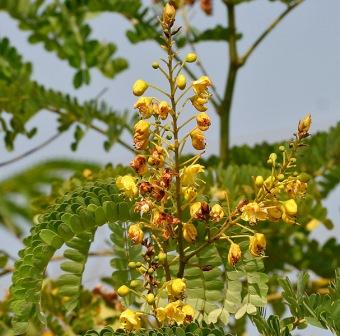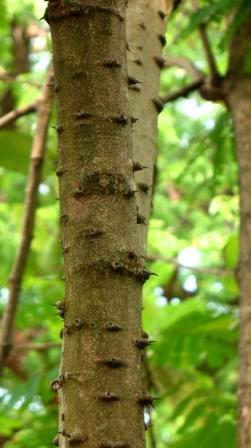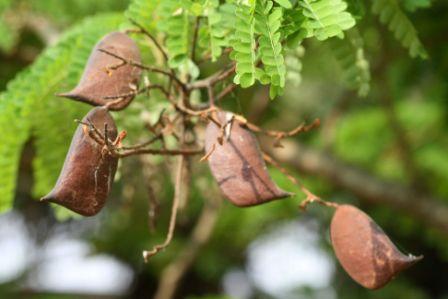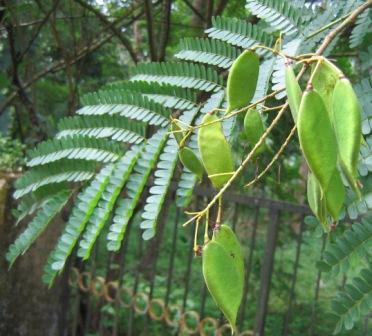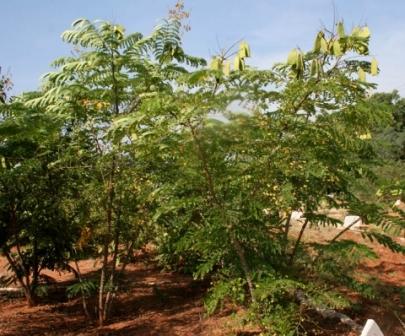Sappan wood/Pathimukham
Caesalpinia sappan
Description
General Information :
- Shrub by tree up to 10 m tall
- Bark greyish brown;
- Young twigs and buds hairy brownish.
- Leaves dark green in color.
Distribution :
- Sappan wood belongs to the same genus as Brazil wood. It is cultivated in all parts of Tamil Nadu, Kerala, Karnataka, Andra Pradesh and West Bengal.
Habitat : It prefers a sub tropical climate to tropical climate.
Soil : Under natural conditions Caesalpinia sappan grows mostly in hilly areas with clayey soil and calcareous rocks at low and medium altitudes
Altitude :1000m
Rainfall :700–4300 mm
Temperature : 24–28°C
Terrain : It grows mostly in hilly areas
Tree Characteristics :
- Strong light demander and intolerant of suppression.
- Drought resistant,very hardy.
- The trees are very hardy to injuries and do not die untill in contrast to most of th forest trees whn gridled.
Habit : Tropical moist deciduous and Tropical forest.
Planting Guidelines
Natural Regeneration :
- Naturally Propagated by seed.
Artificial Regeneration :
- Propagated by seedlings and cuttings
Seed collection and Storage :
- .The mature pods are collected in the month April-May
- Mature pods burst open in the dry season
- The seeds are removed from pod by bursted out the pod.
- The seeds can be stored for 2-3 months in gunny bags.
- Germination rate is 90%.
Seed Treatment :
- Pods are gathered, pounded and put into cold water.
- Seed germination occurs readily but is enhanced by dipping seeds wrapped in cotton cloth in boiling water for 5 seconds.
-
Nursery Technique :
- Seeds can be sown directly on mother beds in patches and cover lightly with soil in rainy season.
- If fresh seeds are sown 90 to 100 percent germination can be achieved.
- Partial shade is necessary for initial establishment of seedlings.
- The weeding and watering should be in regular interval for certain period.
Cuttings:
- The cuttings from the species can be used in nursery.
- The semi-hard wood cuttings are mostly suitable for nursery management.
- Cuttings are dipped in IBA and then planted in the nursery bed.
Plantation technique :
- Seedlings are planted 1 x 2 meters apart for windbreaks and at 2 x 2 meters in plantations.
- For shade trees, spacing varies from 5 to 10 meters, depending on the companion crop and site.
Care & Disease Control :
- Pruning and tipping of the tree as on when required.
Irrigation :
- For proper growth and survival it is necessary to give one or two waterings after planting. This is specifically required in arid regions.
- Irrigation after planting is not a prerequisite in areas having sufficient soil moisture and precipitation.
- Higher survival rate and better rate of growth is reported when soil and water conservation measures are also adopted.
Recommended Harvest :
- The main branches along with the stump are harvested.
- Seeds can be harvested right from the second year of planting but the heartwood is ready only after 6-12 years.
Yield :
- Average yield of inner pulp is about 80kg/tree.
- An yield of 2000-2500kg of pods may be obtained, which inturn may yield 200-250 kg seeds per hectare.
- The harvested wood is chipped into pieces and the dye is extracted boiling them in water.
Agro Forestory :
- The tree is often planted as a living fence.
- Owing to its easy growth and dense growth habit, it is used for defining the boundaries of land and for protecting plantations against grazing animals
Major uses :
- The heartwood yields a valuable red crystalline dye used on cotton, silk and wool fabrics.
- Bark and pods yield similar dyes, 40% tannin used for production of light leather goods.
- Roots give a yellow dye.
- Sappan yields different shades of red with or without mordant which are frequently used to increase the binding potential of the dye
- The fruits contain tannin and were used in the past to prepare a black dye in combination with an iron mordant.
- The wood has been used in cabinet-making since mediaeval times, especially for inlay decoration. It also is a good source of firewood.
- Caesalpinia sappan is often planted as a living fence and ornamental.
- Owing to its easy growth and dense growth habit, it is used for defining the boundaries of land and for protecting plantations against grazing animals.
- The leaves can be used to hasten ripening of fruits such as bananas and mangoes.
Market details :
Outputs/acre:
- Expected quantity of heart wood - 25 to 50Kg per plant
- Total expecting weight - 25Kg x 1000nos. = 25,000Kg
- Present market value - Rs.70 per Kg
- Expected Total Outcome (7 years maturity) - Rs. 17,50,000 per acre


